check engine YAMAHA WR 250F 2010 User Guide
[x] Cancel search | Manufacturer: YAMAHA, Model Year: 2010, Model line: WR 250F, Model: YAMAHA WR 250F 2010Pages: 232, PDF Size: 13.94 MB
Page 66 of 232
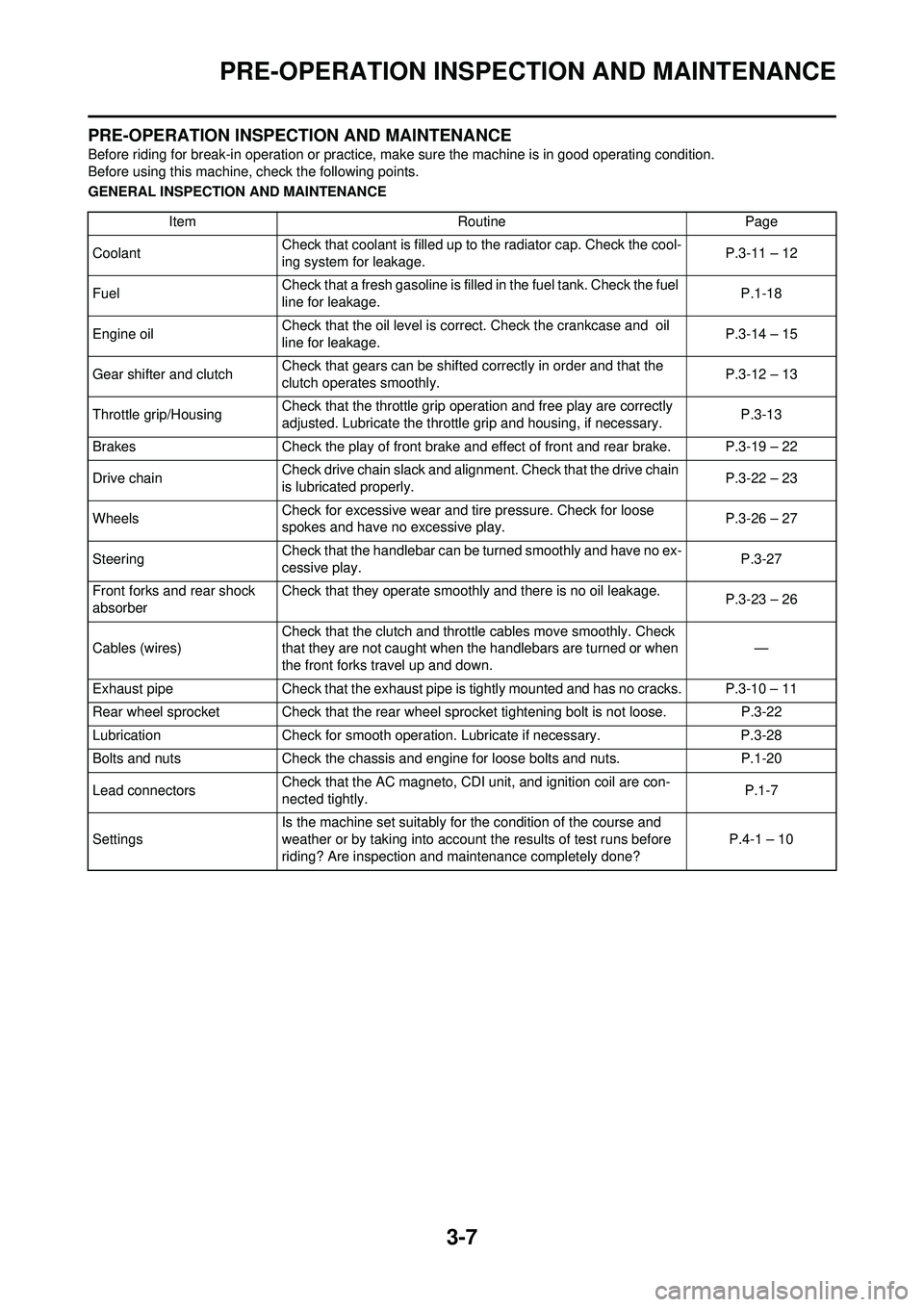
3-7
PRE-OPERATION INSPECTION AND MAINTENANCE
PRE-OPERATION INSPECTION AND MAINTENANCE
Before riding for break-in operation or practice, make sure the machine is in good operating condition.
Before using this machine, check the following points.
GENERAL INSPECTION AND MAINTENANCEItem RoutinePage
Coolant Check that coolant is filled up to the radiator cap. Check the cool-
ing system for leakage. P.3-11 – 12
Fuel Check that a fresh gasoline is filled in the fuel tank. Check the fuel
line for leakage.
P.1-18
Engine oil Check that the oil level is corre
ct. Check the crankcase and oil
line for leakage. P.3-14 – 15
Gear shifter and clutch Check that gears can be shifted correctly in order and that the
clutch operates smoothly. P.3-12 – 13
Throttle grip/Housing Check that the throttle grip operation and free play are correctly
adjusted. Lubricate the throttle grip and housing, if necessary.
P.3-13
Brakes Check the play of front brake and ef fect of front and rear brake. P.3-19 – 22
Drive chain Check drive chain slack and alignment. Check that the drive chain
is lubricated properly. P.3-22 – 23
Wheels Check for excessive wear and ti
re pressure. Check for loose
spokes and have no excessive play. P.3-26 – 27
Steering Check that the handlebar can be turned smoothly and have no ex-
cessive play.
P.3-27
Front forks and rear shock
absorber Check that they operate smoothly and there is no oil leakage.
P.3-23 – 26
Cables (wires) Check that the clutch and throttle cables move smoothly. Check
that they are not caught when the handlebars are turned or when
the front forks travel up and down. —
Exhaust pipe Check that the exhaust pipe is tightly mount ed and has no cracks. P.3-10 – 11
Rear wheel sprocket Check that the rear wheel sprocket tightening bolt is not loose. P.3-22
Lubrication Check for smooth operation. Lubricate if necessary. P.3-28
Bolts and nuts Check the chassis and engine for loose bolts and nuts. P.1-20
Lead connectors Check that the AC magneto, CDI unit, and ignition coil are con-
nected tightly. P.1-7
Settings Is the machine set suitably for the condition of the course and
weather or by taking into account the results of test runs before
riding? Are inspection and maintenance completely done? P.4-1 – 10
Page 70 of 232
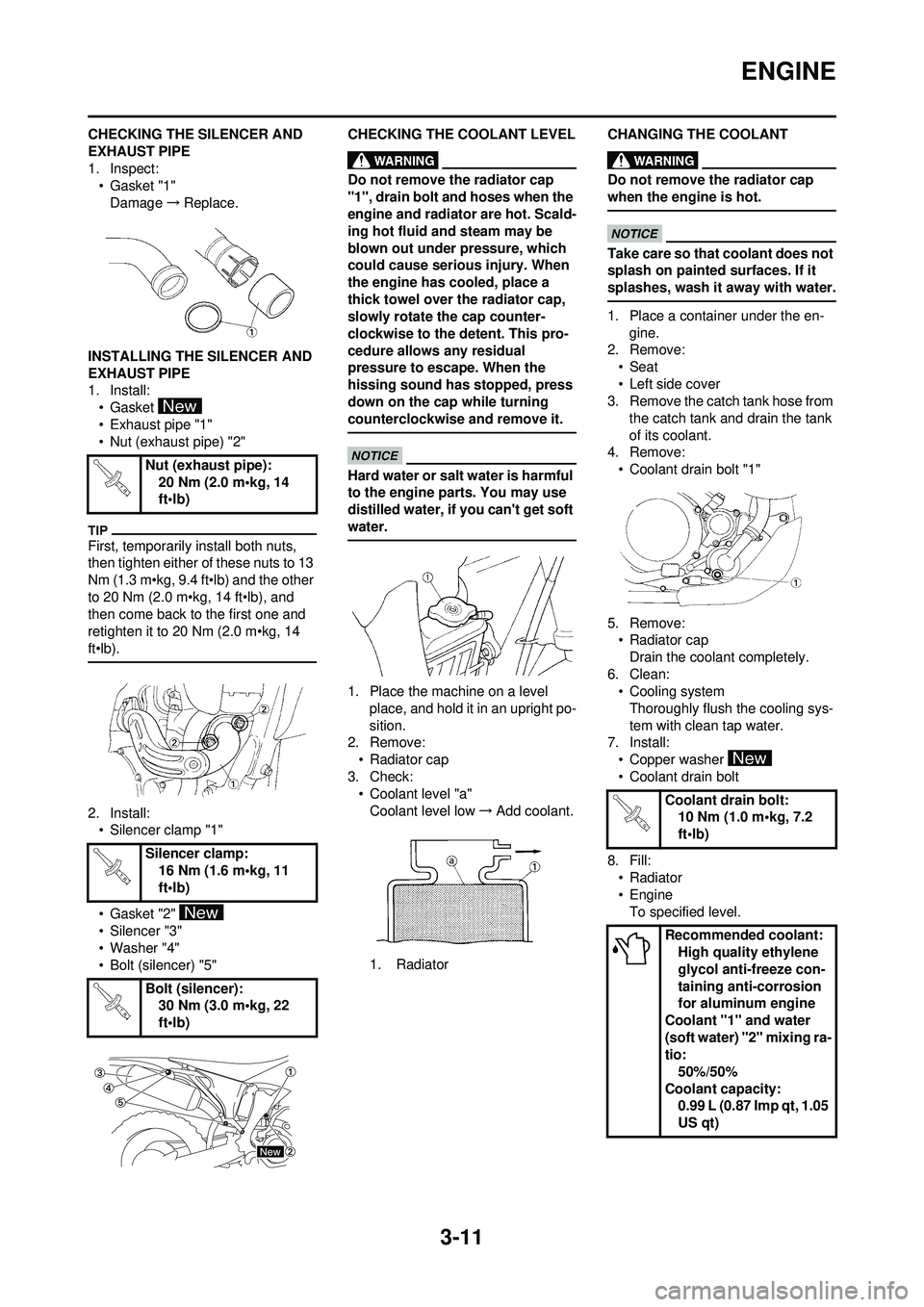
3-11
ENGINE
CHECKING THE SILENCER AND
EXHAUST PIPE
1. Inspect:• Gasket "1"
Damage →Replace.
INSTALLING THE SILENCER AND
EXHAUST PIPE
1. Install: • Gasket
• Exhaust pipe "1"
• Nut (exhaust pipe) "2"
First, temporarily install both nuts,
then tighten either of these nuts to 13
Nm (1.3 m•kg, 9.4 ft•lb) and the other
to 20 Nm (2.0 m•kg, 14 ft•lb), and
then come back to the first one and
retighten it to 20 Nm (2.0 m•kg, 14
ft•lb).
2. Install: • Silencer clamp "1"
• Gasket "2"
• Silencer "3"
• Washer "4"
• Bolt (silencer) "5" CHECKING THE COOLANT LEVEL
Do not remove the radiator cap
"1", drain bolt and hoses when the
engine and radiator are hot. Scald-
ing hot fluid and steam may be
blown out under pressure, which
could cause serious injury. When
the engine has cooled, place a
thick towel over the radiator cap,
slowly rotate the cap counter-
clockwise to the detent. This pro-
cedure allows any residual
pressure to escape. When the
hissing sound has stopped, press
down on the cap while turning
counterclockwise and remove it.
Hard water or salt water is harmful
to the engine parts. You may use
distilled water, if you can't get soft
water.
1. Place the machine on a level
place, and hold it in an upright po-
sition.
2. Remove: • Radiator cap
3. Check: • Coolant level "a"Coolant level low →Add coolant.
1. Radiator CHANGING THE COOLANT
Do not remove the radiator cap
when the engine is hot.
Take care so that coolant does not
splash on painted surfaces. If it
splashes, wash it away with water.
1. Place a container under the en-
gine.
2. Remove:
• Seat
• Left side cover
3. Remove the catch tank hose from
the catch tank and drain the tank
of its coolant.
4. Remove:
• Coolant drain bolt "1"
5. Remove: • Radiator capDrain the coolant completely.
6. Clean: • Cooling systemThoroughly flush the cooling sys-
tem with clean tap water.
7. Install: • Copper washer
• Coolant drain bolt
8. Fill: •Radiator
• Engine
To specified level.
Nut (exhaust pipe):
20 Nm (2.0 m•kg, 14
ft•lb)
Silencer clamp: 16 Nm (1.6 m•kg, 11
ft•lb)
Bolt (silencer): 30 Nm (3.0 m•kg, 22
ft•lb)
Coolant drain bolt:10 Nm (1.0 m•kg, 7.2
ft•lb)
Recommended coolant: High quality ethylene
glycol anti-freeze con-
taining anti-corrosion
for aluminum engine
Coolant "1" and water
(soft water) "2" mixing ra-
tio: 50%/50%
Coolant capacity: 0.99 L (0.87 Imp qt, 1.05
US qt)
Page 71 of 232
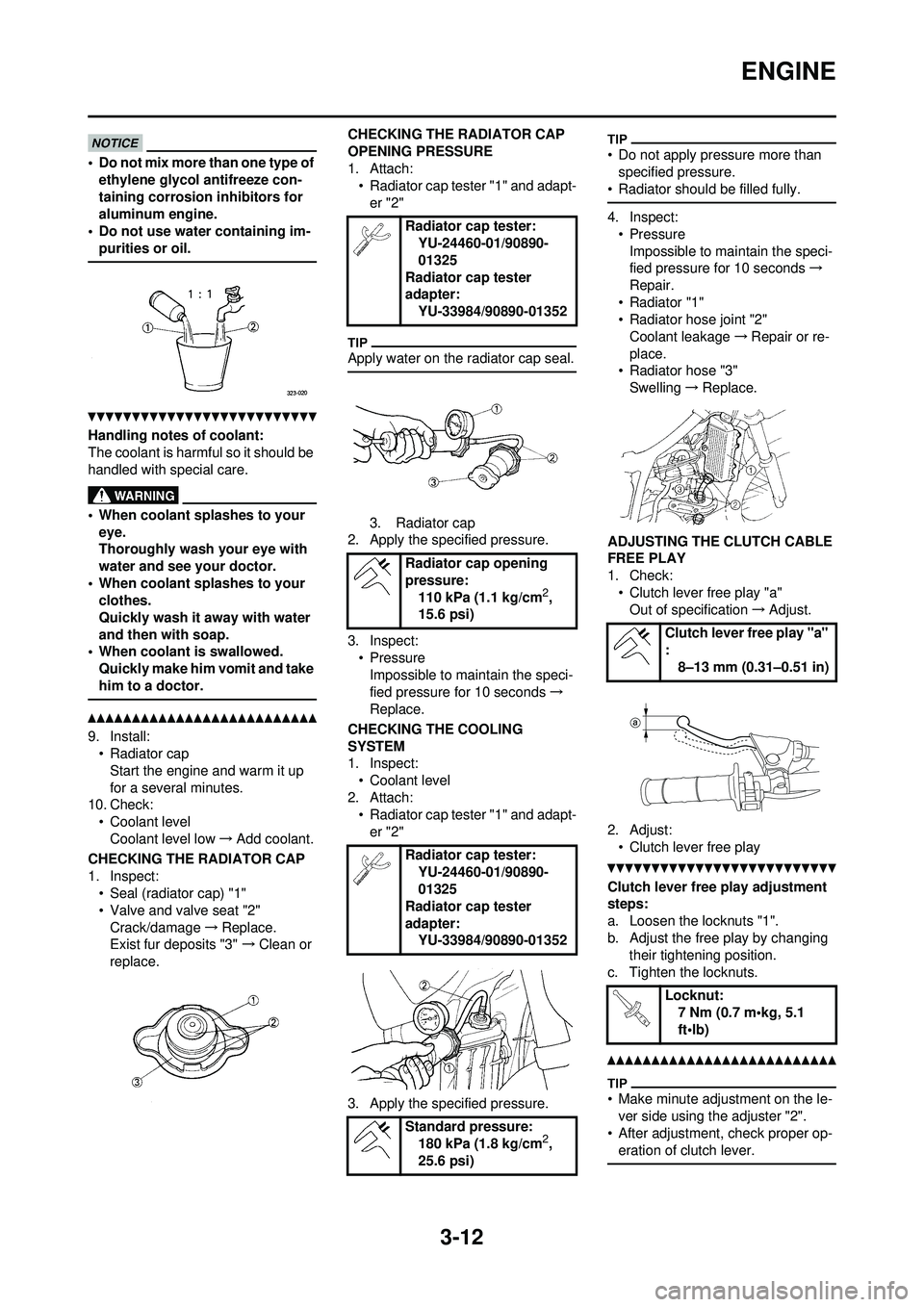
3-12
ENGINE
• Do not mix more than one type of ethylene glycol antifreeze con-
taining corrosion inhibitors for
aluminum engine.
• Do not use water containing im-
purities or oil.
Handling notes of coolant:
The coolant is harmful so it should be
handled with special care.
• When coolant splashes to your eye.
Thoroughly wash your eye with
water and see your doctor.
• When coolant splashes to your clothes.
Quickly wash it away with water
and then with soap.
• When coolant is swallowed. Quickly make him vomit and take
him to a doctor.
9. Install:• Radiator cap
Start the engine and warm it up
for a several minutes.
10. Check:
• Coolant levelCoolant level low →Add coolant.
CHECKING THE RADIATOR CAP
1. Inspect: • Seal (radiator cap) "1"
• Valve and valve seat "2"Crack/damage →Replace.
Exist fur deposits "3" →Clean or
replace. CHECKING THE RADIATOR CAP
OPENING PRESSURE
1. Attach:
• Radiator cap tester "1" and adapt-
er "2"
Apply water on the radiator cap seal.
3. Radiator cap
2. Apply the specified pressure.
3. Inspect:
•PressureImpossible to maintain the speci-
fied pressure for 10 seconds →
Replace.
CHECKING THE COOLING
SYSTEM
1. Inspect: • Coolant level
2. Attach: • Radiator cap tester "1" and adapt-
er "2"
3. Apply the specified pressure.
• Do not apply pressure more than specified pressure.
• Radiator should be filled fully.
4. Inspect: • PressureImpossible to maintain the speci-
fied pressure for 10 seconds →
Repair.
•Radiator "1"
• Radiator hose joint "2"
Coolant leakage →Repair or re-
place.
• Radiator hose "3"
Swelling →Replace.
ADJUSTING THE CLUTCH CABLE
FREE PLAY
1. Check: • Clutch lever free play "a"Out of specification →Adjust.
2. Adjust: • Clutch lever free play
Clutch lever free play adjustment
steps:
a. Loosen the locknuts "1".
b. Adjust the free play by changing their tightening position.
c. Tighten the locknuts.
• Make minute adjustment on the le- ver side using the adjuster "2".
• After adjustment, check proper op- eration of clutch lever.
Radiator cap tester: YU-24460-01/90890-
01325
Radiator cap tester
adapter: YU-33984/90890-01352
Radiator cap opening
pressure: 110 kPa (1.1 kg/cm
2,
15.6 psi)
Radiator cap tester: YU-24460-01/90890-
01325
Radiator cap tester
adapter: YU-33984/90890-01352
Standard pressure: 180 kPa (1.8 kg/cm
2,
25.6 psi)
Clutch lever free play "a"
: 8–13 mm (0.31–0.51 in)
Locknut: 7 Nm (0.7 m•kg, 5.1
ft•lb)
Page 72 of 232
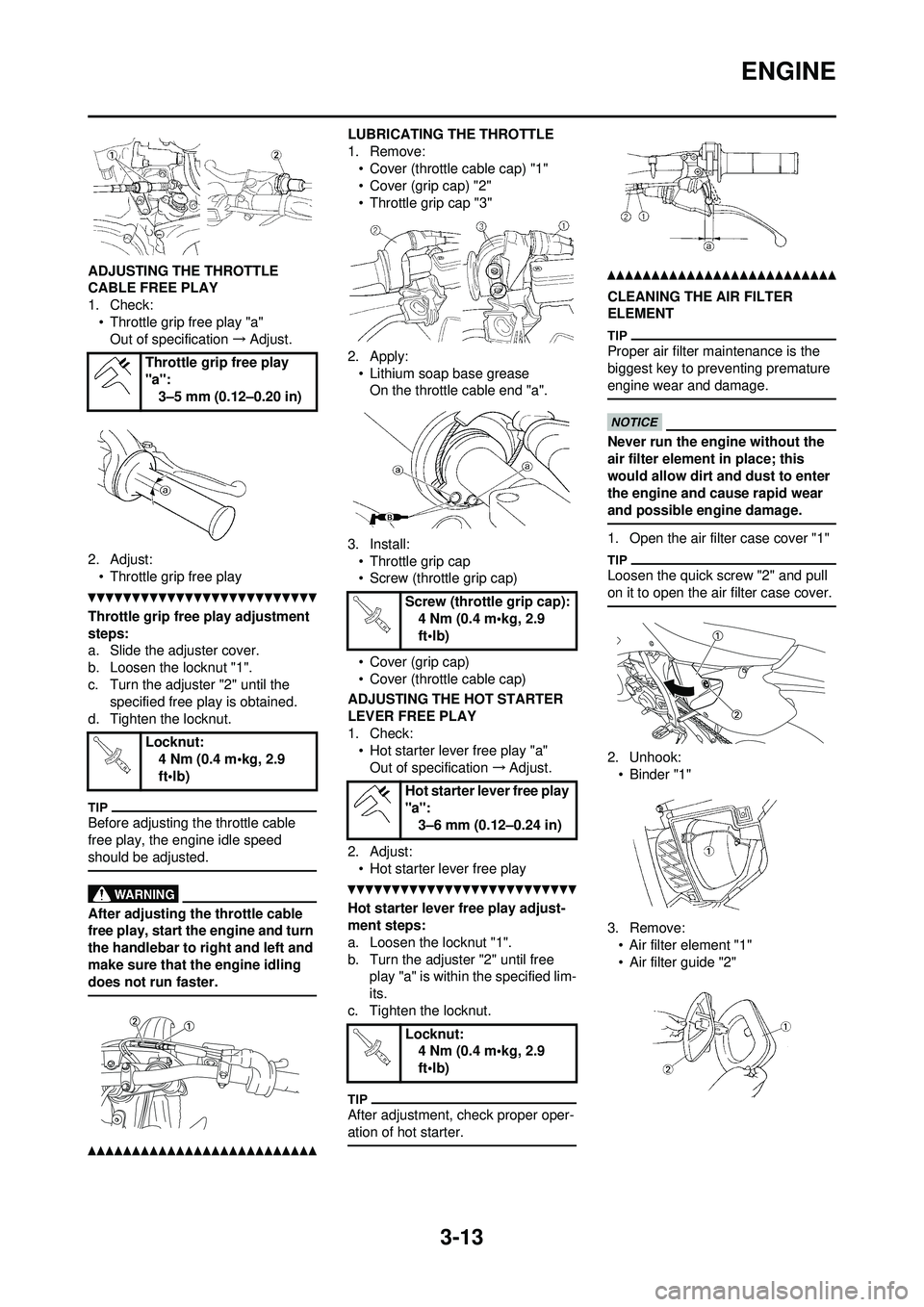
3-13
ENGINE
ADJUSTING THE THROTTLE
CABLE FREE PLAY
1. Check:• Throttle grip free play "a"Out of specification →Adjust.
2. Adjust: • Throttle grip free play
Throttle grip free play adjustment
steps:
a. Slide the adjuster cover.
b. Loosen the locknut "1".
c. Turn the adjuster "2" until the specified free play is obtained.
d. Tighten the locknut.
Before adjusting the throttle cable
free play, the engine idle speed
should be adjusted.
After adjusting the throttle cable
free play, start the engine and turn
the handlebar to right and left and
make sure that the engine idling
does not run faster.
LUBRICATING THE THROTTLE
1. Remove: • Cover (throttle cable cap) "1"
• Cover (grip cap) "2"
• Throttle grip cap "3"
2. Apply: • Lithium soap base greaseOn the throttle cable end "a".
3. Install: • Throttle grip cap
• Screw (throttle grip cap)
• Cover (grip cap)
• Cover (throttle cable cap)
ADJUSTING THE HOT STARTER
LEVER FREE PLAY
1. Check: • Hot starter lever free play "a"
Out of specification →Adjust.
2. Adjust: • Hot starter lever free play
Hot starter lever free play adjust-
ment steps:
a. Loosen the locknut "1".
b. Turn the adjuster "2" until free play "a" is within the specified lim-
its.
c. Tighten the locknut.
After adjustment, check proper oper-
ation of hot starter.
CLEANING THE AIR FILTER
ELEMENT
Proper air filter ma intenance is the
biggest key to preventing premature
engine wear and damage.
Never run the engine without the
air filter element in place; this
would allow dirt and dust to enter
the engine and cause rapid wear
and possible engine damage.
1. Open the air filter case cover "1"
Loosen the quick screw "2" and pull
on it to open the air filter case cover.
2. Unhook: •Binder "1"
3. Remove: • Air filter element "1"
• Air filter guide "2"
Throttle grip free play
"a":
3–5 mm (0.12–0.20 in)
Locknut: 4 Nm (0.4 m•kg, 2.9
ft•lb)
Screw (throttle grip cap):4 Nm (0.4 m•kg, 2.9
ft•lb)
Hot starter lever free play
"a": 3–6 mm (0.12–0.24 in)
Locknut: 4 Nm (0.4 m•kg, 2.9
ft•lb)
Page 73 of 232
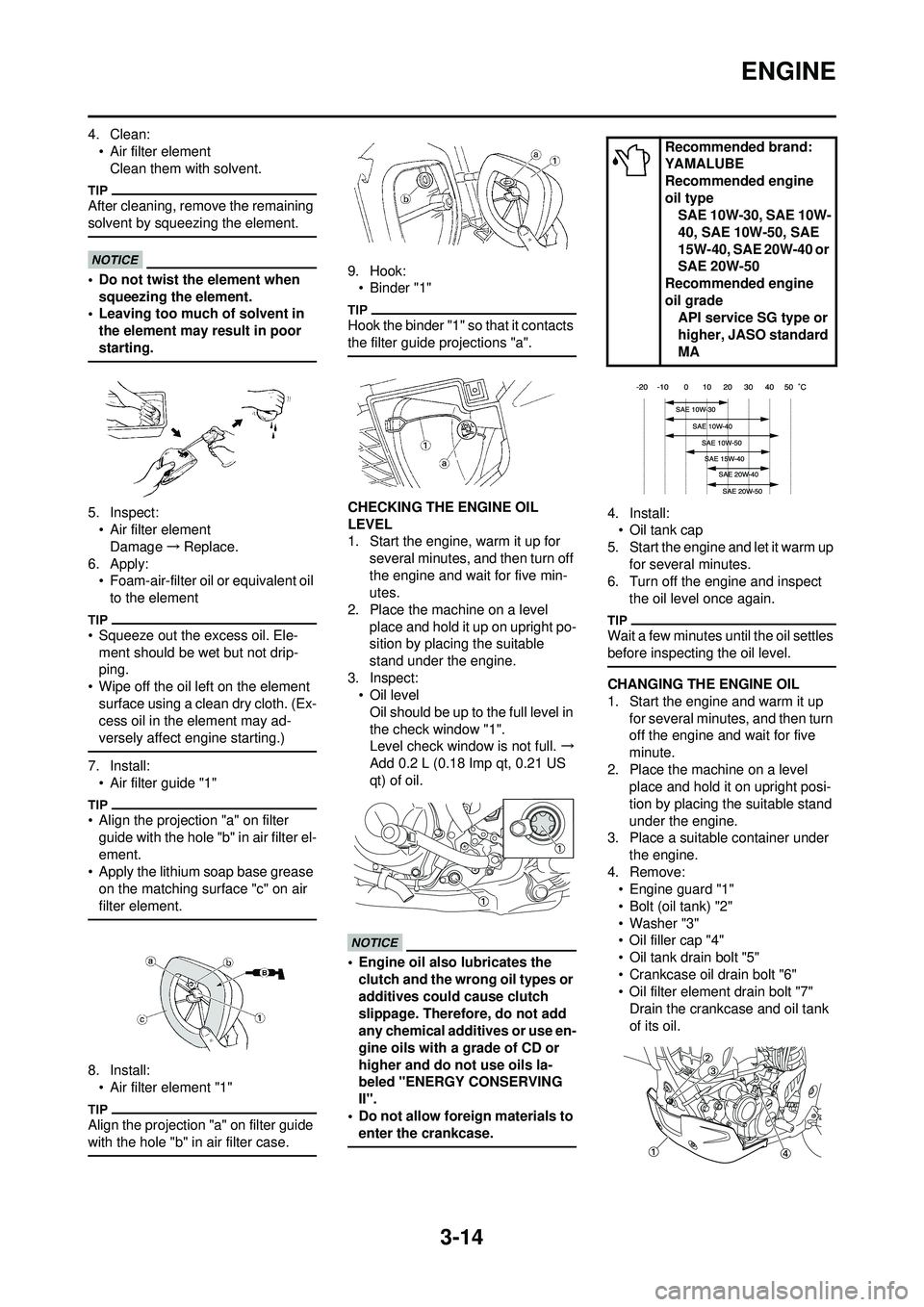
3-14
ENGINE
4. Clean:• Air filter elementClean them with solvent.
After cleaning, remo ve the remaining
solvent by squeezing the element.
• Do not twist the element when squeezing the element.
• Leaving too much of solvent in
the element may result in poor
starting.
5. Inspect:• Air filter elementDamage →Replace.
6. Apply: • Foam-air-filter oil or equivalent oil to the element
• Squeeze out the excess oil. Ele-
ment should be wet but not drip-
ping.
• Wipe off the oil left on the element
surface using a clean dry cloth. (Ex-
cess oil in the element may ad-
versely affect engine starting.)
7. Install:• Air filter guide "1"
• Align the projection "a" on filter
guide with the hole "b" in air filter el-
ement.
• Apply the lithium soap base grease
on the matching surface "c" on air
filter element.
8. Install:• Air filter element "1"
Align the projection "a" on filter guide
with the hole "b" in air filter case.
9. Hook:• Binder "1"
Hook the binder "1" so that it contacts
the filter guide projections "a".
CHECKING THE ENGINE OIL
LEVEL
1. Start the engine, warm it up for several minutes, and then turn off
the engine and wait for five min-
utes.
2. Place the machine on a level
place and hold it up on upright po-
sition by placing the suitable
stand under the engine.
3. Inspect: • Oil levelOil should be up to the full level in
the check window "1".
Level check window is not full. →
Add 0.2 L (0.18 Imp qt, 0.21 US
qt) of oil.
• Engine oil also lubricates the
clutch and the wrong oil types or
additives could cause clutch
slippage. Therefore, do not add
any chemical additives or use en-
gine oils with a grade of CD or
higher and do not use oils la-
beled "ENERGY CONSERVING
II".
• Do not allow fore ign materials to
enter the crankcase.
4. Install: • Oil tank cap
5. Start the engine and let it warm up for several minutes.
6. Turn off the engine and inspect
the oil level once again.
Wait a few minutes until the oil settles
before inspecting the oil level.
CHANGING THE ENGINE OIL
1. Start the engine and warm it up for several minutes, and then turn
off the engine and wait for five
minute.
2. Place the machine on a level place and hold it on upright posi-
tion by placing the suitable stand
under the engine.
3. Place a suitable container under
the engine.
4. Remove: • Engine guard "1"
• Bolt (oil tank) "2"
• Washer "3"
• Oil filler cap "4"
• Oil tank drain bolt "5"
• Crankcase oil drain bolt "6"
• Oil filter element drain bolt "7"
Drain the crankcase and oil tank
of its oil.
Recommended brand:
YAMALUBE
Recommended engine
oil type SAE 10W-30, SAE 10W-
40, SAE 10W-50, SAE
15W-40, SAE 20W-40 or
SAE 20W-50
Recommended engine
oil grade API service SG type or
higher, JASO standard
MA
Page 74 of 232
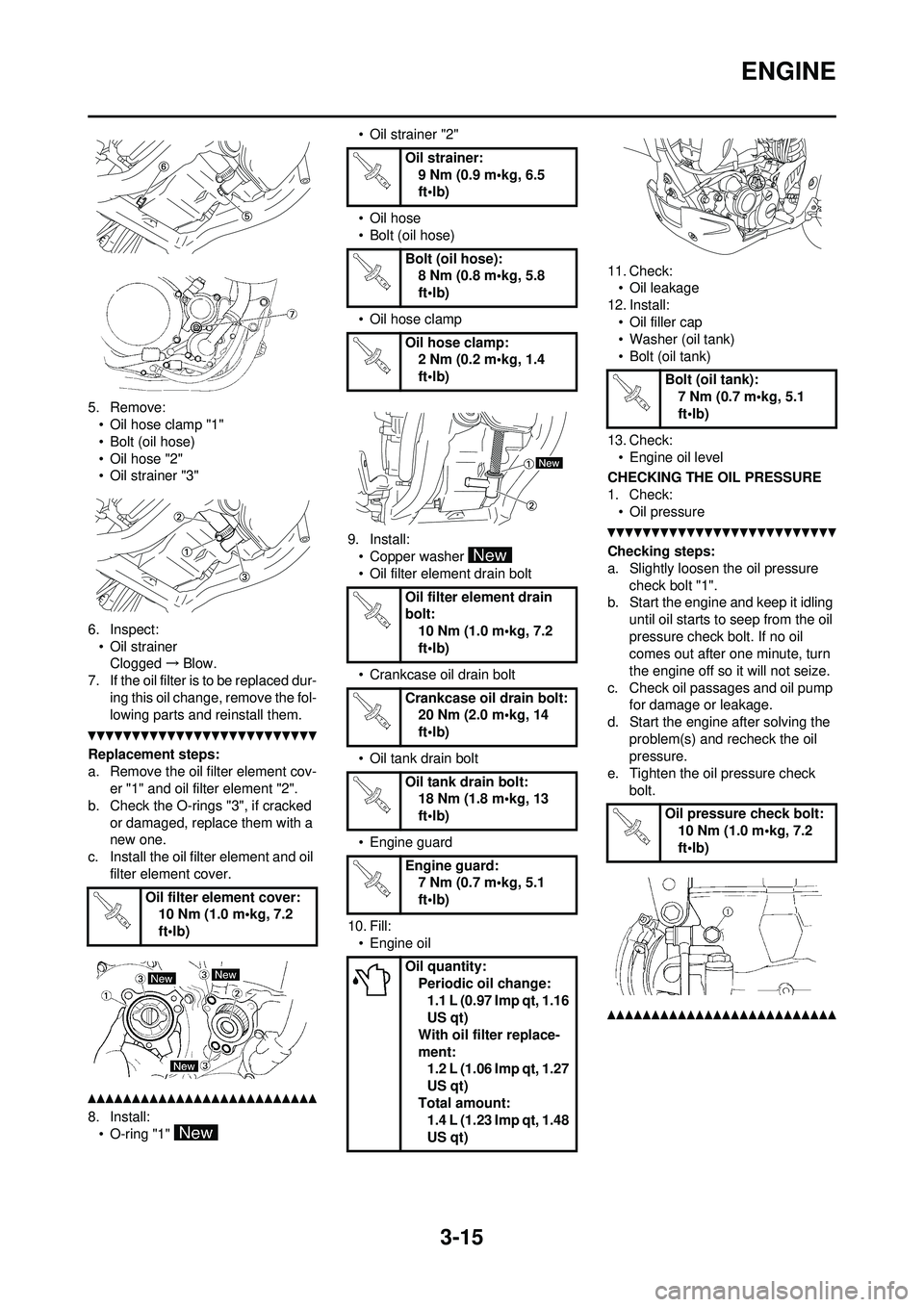
3-15
ENGINE
5. Remove:• Oil hose clamp "1"
• Bolt (oil hose)
• Oil hose "2"
• Oil strainer "3"
6. Inspect: • Oil strainerClogged →Blow.
7. If the oil filter is to be replaced dur-
ing this oil change, remove the fol-
lowing parts and reinstall them.
Replacement steps:
a. Remove the oil filter element cov-er "1" and oil filter element "2".
b. Check the O-rings "3", if cracked or damaged, replace them with a
new one.
c. Install the oil filter element and oil filter element cover.
8. Install:
• O-ring "1" • Oil strainer "2"
• Oil hose
• Bolt (oil hose)
• Oil hose clamp
9. Install: • Copper washer
• Oil filter element drain bolt
• Crankcase oil drain bolt
• Oil tank drain bolt
• Engine guard
10. Fill: • Engine oil 11. Check:
• Oil leakage
12. Install: • Oil filler cap
• Washer (oil tank)
• Bolt (oil tank)
13. Check: • Engine oil level
CHECKING THE OIL PRESSURE
1. Check: • Oil pressure
Checking steps:
a. Slightly loosen the oil pressure check bolt "1".
b. Start the engine and keep it idling
until oil starts to seep from the oil
pressure check bolt. If no oil
comes out after one minute, turn
the engine off so it will not seize.
c. Check oil passages and oil pump for damage or leakage.
d. Start the engine after solving the problem(s) and recheck the oil
pressure.
e. Tighten the oil pressure check bolt.
Oil filter element cover:10 Nm (1.0 m•kg, 7.2
ft•lb)
Oil strainer:
9 Nm (0.9 m•kg, 6.5
ft•lb)
Bolt (oil hose): 8 Nm (0.8 m•kg, 5.8
ft•lb)
Oil hose clamp: 2 Nm (0.2 m•kg, 1.4
ft•lb)
Oil filter element drain
bolt: 10 Nm (1.0 m•kg, 7.2
ft•lb)
Crankcase oil drain bolt: 20 Nm (2.0 m•kg, 14
ft•lb)
Oil tank drain bolt: 18 Nm (1.8 m•kg, 13
ft•lb)
Engine guard: 7 Nm (0.7 m•kg, 5.1
ft•lb)
Oil quantity: Periodic oil change:
1.1 L (0.97 Imp qt, 1.16
US qt)
With oil filter replace-
ment: 1.2 L (1.06 Imp qt, 1.27
US qt)
Total amount: 1.4 L (1.23 Imp qt, 1.48
US qt)
Bolt (oil tank): 7 Nm (0.7 m•kg, 5.1
ft•lb)
Oil pressure check bolt: 10 Nm (1.0 m•kg, 7.2
ft•lb)
Page 75 of 232
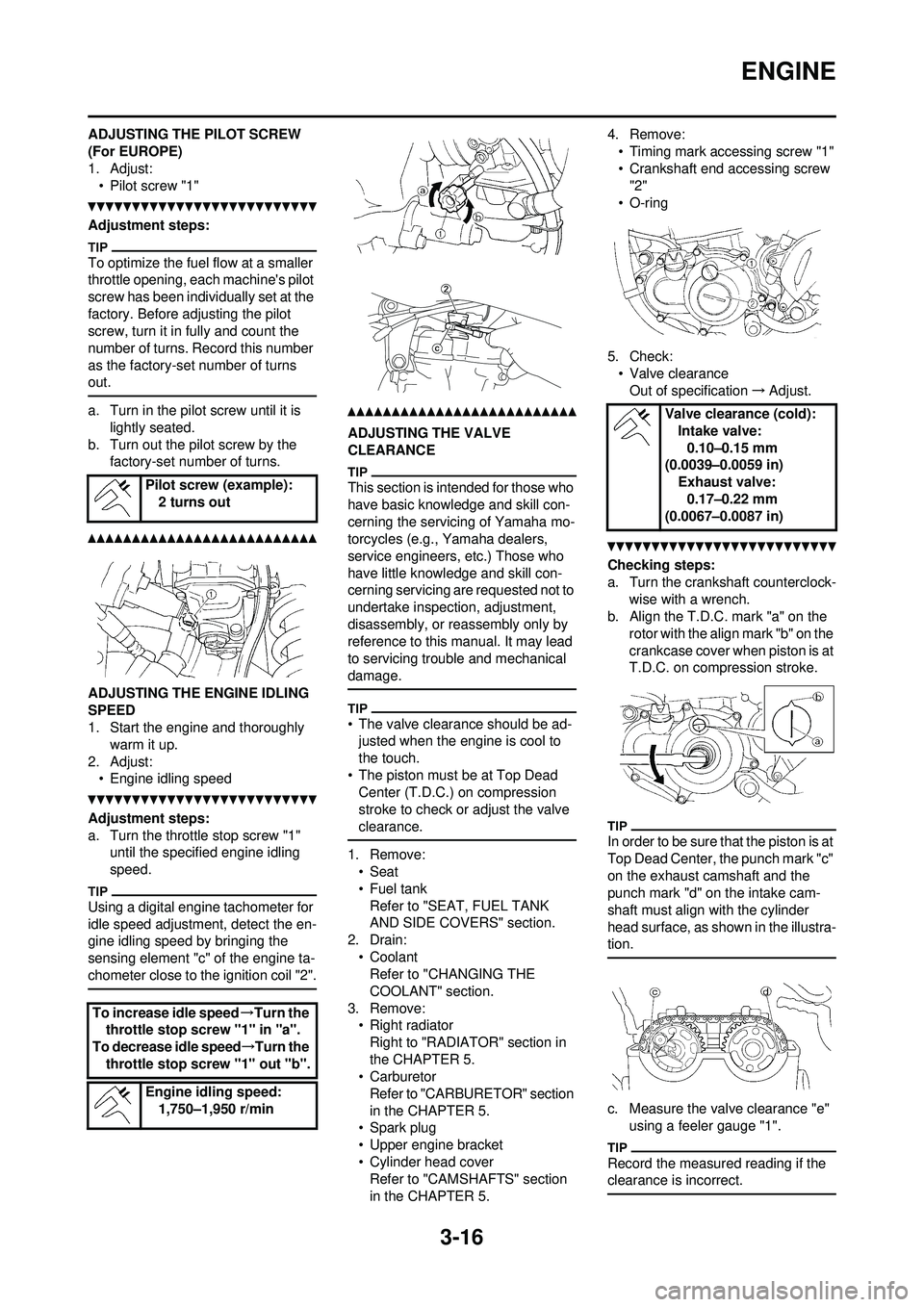
3-16
ENGINE
ADJUSTING THE PILOT SCREW
(For EUROPE)
1. Adjust:• Pilot screw "1"
Adjustment steps:
To optimize the fuel flow at a smaller
throttle opening, each machine's pilot
screw has been individually set at the
factory. Before adjusting the pilot
screw, turn it in fully and count the
number of turns. Record this number
as the factory-set number of turns
out.
a. Turn in the pilot screw until it is lightly seated.
b. Turn out the pilot screw by the factory-set number of turns.
ADJUSTING THE ENGINE IDLING
SPEED
1. Start the engine and thoroughly warm it up.
2. Adjust: • Engine idling speed
Adjustment steps:
a. Turn the throttle stop screw "1" until the specified engine idling
speed.
Using a digital engine tachometer for
idle speed adjustment, detect the en-
gine idling speed by bringing the
sensing element "c" of the engine ta-
chometer close to the ignition coil "2".
ADJUSTING THE VALVE
CLEARANCE
This section is intended for those who
have basic knowledge and skill con-
cerning the servicing of Yamaha mo-
torcycles (e.g., Yamaha dealers,
service engineers, etc.) Those who
have little knowledge and skill con-
cerning servicing are requested not to
undertake inspection, adjustment,
disassembly, or reassembly only by
reference to this manual. It may lead
to servicing trouble and mechanical
damage.
• The valve clearance should be ad-justed when the engine is cool to
the touch.
• The piston must be at Top Dead Center (T.D.C.) on compression
stroke to check or adjust the valve
clearance.
1. Remove:•Seat
•Fuel tank
Refer to "SEAT, FUEL TANK
AND SIDE COVERS" section.
2. Drain:
• CoolantRefer to "CHANGING THE
COOLANT" section.
3. Remove: • Right radiatorRight to "RADIATOR" section in
the CHAPTER 5.
• Carburetor Refer to "CARBU RETOR" section
in the CHAPTER 5.
• Spark plug
• Upper engine bracket
• Cylinder head cover Refer to "CAMSHAFTS" section
in the CHAPTER 5. 4. Remove:
• Timing mark accessing screw "1"
• Crankshaft end accessing screw "2"
• O-ring
5. Check: • Valve clearanceOut of specification →Adjust.
Checking steps:
a. Turn the crankshaft counterclock-
wise with a wrench.
b. Align the T.D.C. mark "a" on the
rotor with the align mark "b" on the
crankcase cover when piston is at
T.D.C. on compression stroke.
In order to be sure t hat the piston is at
Top Dead Center, the punch mark "c"
on the exhaust camshaft and the
punch mark "d" on the intake cam-
shaft must align with the cylinder
head surface, as shown in the illustra-
tion.
c. Measure the valve clearance "e" using a feeler gauge "1".
Record the measured reading if the
clearance is incorrect.
Pilot screw (example):2 turns out
To increase idle speed →Turn the
throttle stop screw "1" in "a".
To decrease idle speed →Turn the
throttle stop screw "1" out "b".
Engine idling speed:1,750–1,950 r/min
Valve clearance (cold):
Intake valve:0.10–0.15 mm
(0.0039–0.0059 in)
Exhaust valve:0.17–0.22 mm
(0.0067–0.0087 in)
Page 78 of 232
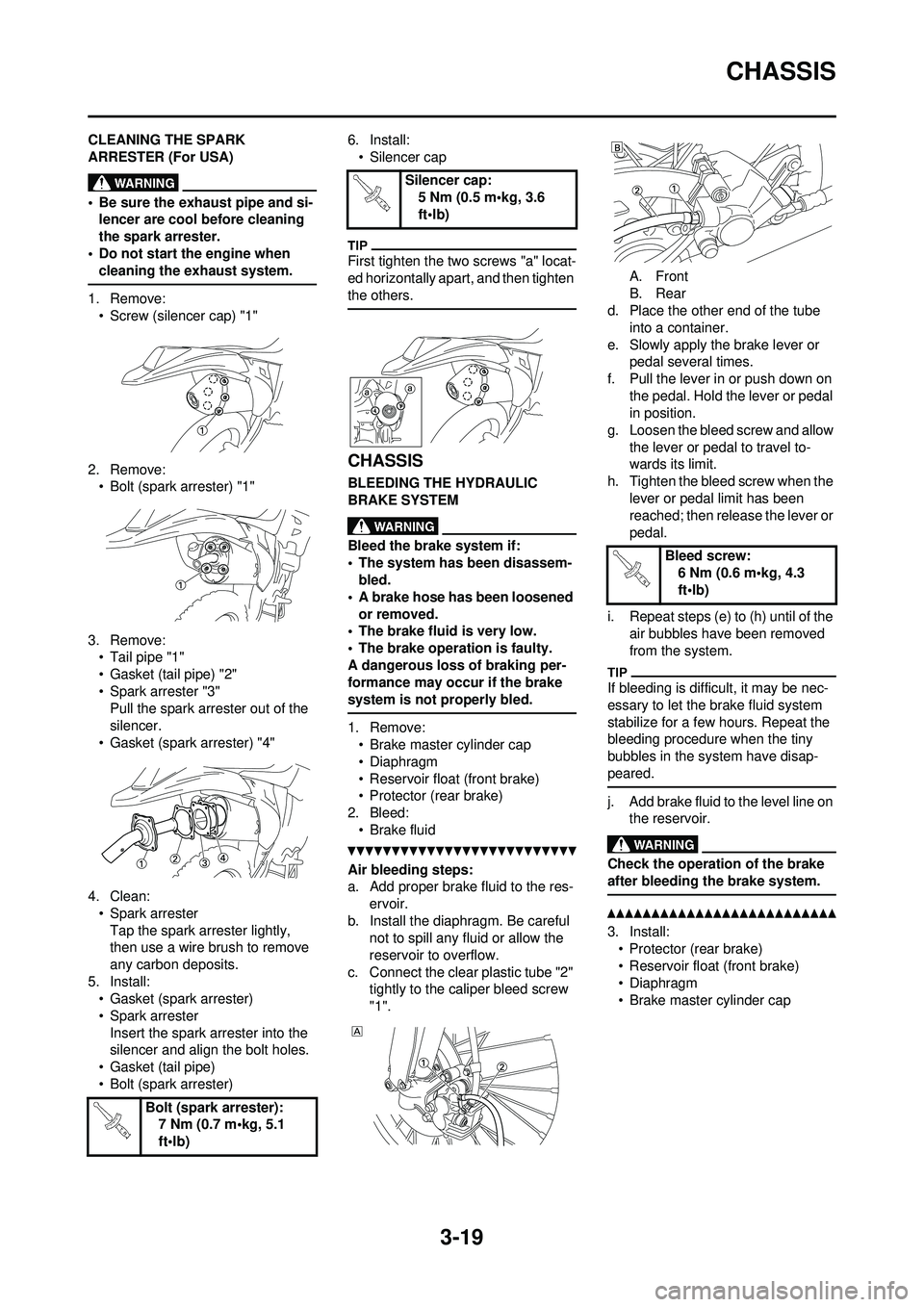
3-19
CHASSIS
CLEANING THE SPARK
ARRESTER (For USA)
• Be sure the exhaust pipe and si-lencer are cool before cleaning
the spark arrester.
• Do not start the engine when cleaning the exhaust system.
1. Remove:• Screw (silencer cap) "1"
2. Remove: • Bolt (spark arrester) "1"
3. Remove: • Tail pipe "1"
• Gasket (tail pipe) "2"
• Spark arrester "3"Pull the spark arrester out of the
silencer.
• Gasket (spark arrester) "4"
4. Clean: • Spark arrester
Tap the spark arrester lightly,
then use a wire brush to remove
any carbon deposits.
5. Install: • Gasket (spark arrester)
• Spark arresterInsert the spark arrester into the
silencer and align the bolt holes.
• Gasket (tail pipe)
• Bolt (spark arrester) 6. Install:
• Silencer cap
First tighten the two screws "a" locat-
ed horizontally apart, and then tighten
the others.
CHASSIS
BLEEDING THE HYDRAULIC
BRAKE SYSTEM
Bleed the brake system if:
• The system has been disassem-bled.
• A brake hose has been loosened
or removed.
• The brake fluid is very low.
• The brake operation is faulty.
A dangerous loss of braking per-
formance may occur if the brake
system is not properly bled.
1. Remove: • Brake master cylinder cap
• Diaphragm
• Reservoir float (front brake)
• Protector (rear brake)
2. Bleed: •Brake fluid
Air bleeding steps:
a. Add proper brake fluid to the res- ervoir.
b. Install the diaphragm. Be careful not to spill any fluid or allow the
reservoir to overflow.
c. Connect the clear plastic tube "2" tightly to the caliper bleed screw
"1". A. Front
B. Rear
d. Place the other end of the tube
into a container.
e. Slowly apply the brake lever or pedal several times.
f. Pull the lever in or push down on
the pedal. Hold the lever or pedal
in position.
g. Loosen the bleed screw and allow
the lever or pedal to travel to-
wards its limit.
h. Tighten the bleed screw when the
lever or pedal limit has been
reached; then release the lever or
pedal.
i. Repeat steps (e) to (h) until of the air bubbles have been removed
from the system.
If bleeding is difficult, it may be nec-
essary to let the brake fluid system
stabilize for a few hours. Repeat the
bleeding procedure when the tiny
bubbles in the system have disap-
peared.
j. Add brake fluid to the level line on the reservoir.
Check the operation of the brake
after bleeding the brake system.
3. Install:
• Protector (rear brake)
• Reservoir float (front brake)
• Diaphragm
• Brake master cylinder cap
Bolt (spark arrester): 7 Nm (0.7 m•kg, 5.1
ft•lb)
Silencer cap:5 Nm (0.5 m•kg, 3.6
ft•lb)
Bleed screw:
6 Nm (0.6 m•kg, 4.3
ft•lb)
Page 82 of 232
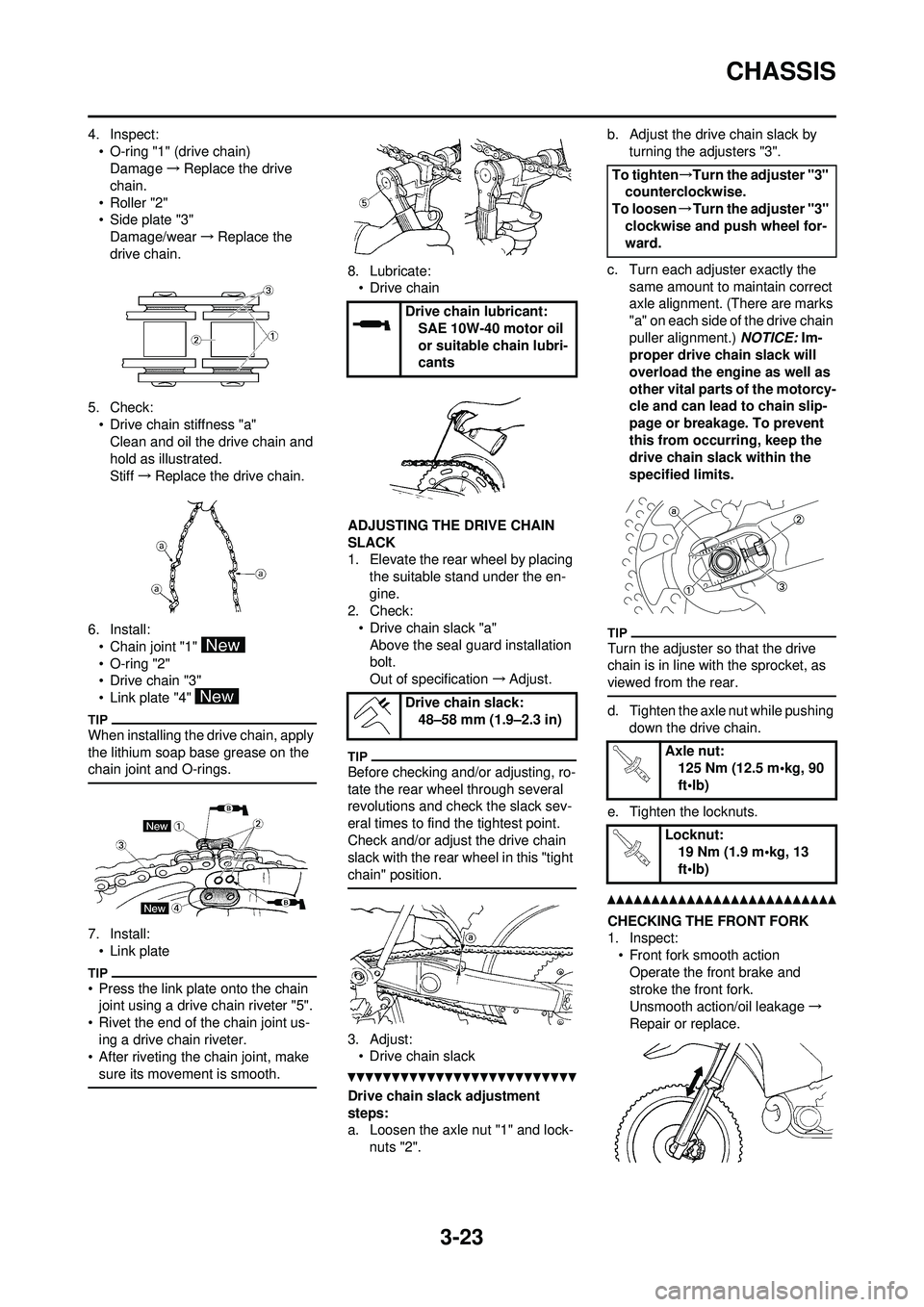
3-23
CHASSIS
4. Inspect:• O-ring "1" (drive chain)Damage →Replace the drive
chain.
•Roller "2"
• Side plate "3" Damage/wear →Replace the
drive chain.
5. Check: • Drive chain stiffness "a"Clean and oil the drive chain and
hold as illustrated.
Stiff →Replace the drive chain.
6. Install: • Chain joint "1"
• O-ring "2"
• Drive chain "3"
• Link plate "4"
When installing the drive chain, apply
the lithium soap base grease on the
chain joint and O-rings.
7. Install:• Link plate
• Press the link plate onto the chain joint using a drive chain riveter "5".
• Rivet the end of the chain joint us- ing a drive chain riveter.
• After riveting the chain joint, make
sure its movement is smooth.
8. Lubricate:• Drive chain
ADJUSTING THE DRIVE CHAIN
SLACK
1. Elevate the rear wheel by placing the suitable stand under the en-
gine.
2. Check:
• Drive chain slack "a"Above the seal guard installation
bolt.
Out of specification →Adjust.
Before checking and/or adjusting, ro-
tate the rear wheel through several
revolutions and check the slack sev-
eral times to find the tightest point.
Check and/or adjust the drive chain
slack with the rear wheel in this "tight
chain" position.
3. Adjust:
• Drive chain slack
Drive chain slack adjustment
steps:
a. Loosen the axle nut "1" and lock-
nuts "2". b. Adjust the drive chain slack by
turning the adjusters "3".
c. Turn each adjuster exactly the same amount to maintain correct
axle alignment. (There are marks
"a" on each side of the drive chain
puller alignment.) NOTICE: Im-
proper drive chain slack will
overload the engine as well as
other vital parts of the motorcy-
cle and can lead to chain slip-
page or breakage. To prevent
this from occurring, keep the
drive chain slack within the
specified limits.
Turn the adjuster so that the drive
chain is in line with the sprocket, as
viewed from the rear.
d. Tighten the axle nut while pushing down the drive chain.
e. Tighten the locknuts.
CHECKING THE FRONT FORK
1. Inspect: • Front fork smooth action
Operate the front brake and
stroke the front fork.
Unsmooth action/oil leakage →
Repair or replace.
Drive chain lubricant: SAE 10W-40 motor oil
or suitable chain lubri-
cants
Drive chain slack: 48–58 mm (1.9–2.3 in)
To tighten →Turn the adjuster "3"
counterclockwise.
To loosen →Turn the adjuster "3"
clockwise and push wheel for-
ward.
Axle nut:125 Nm (12.5 m•kg, 90
ft•lb)
Locknut: 19 Nm (1.9 m•kg, 13
ft•lb)
Page 83 of 232
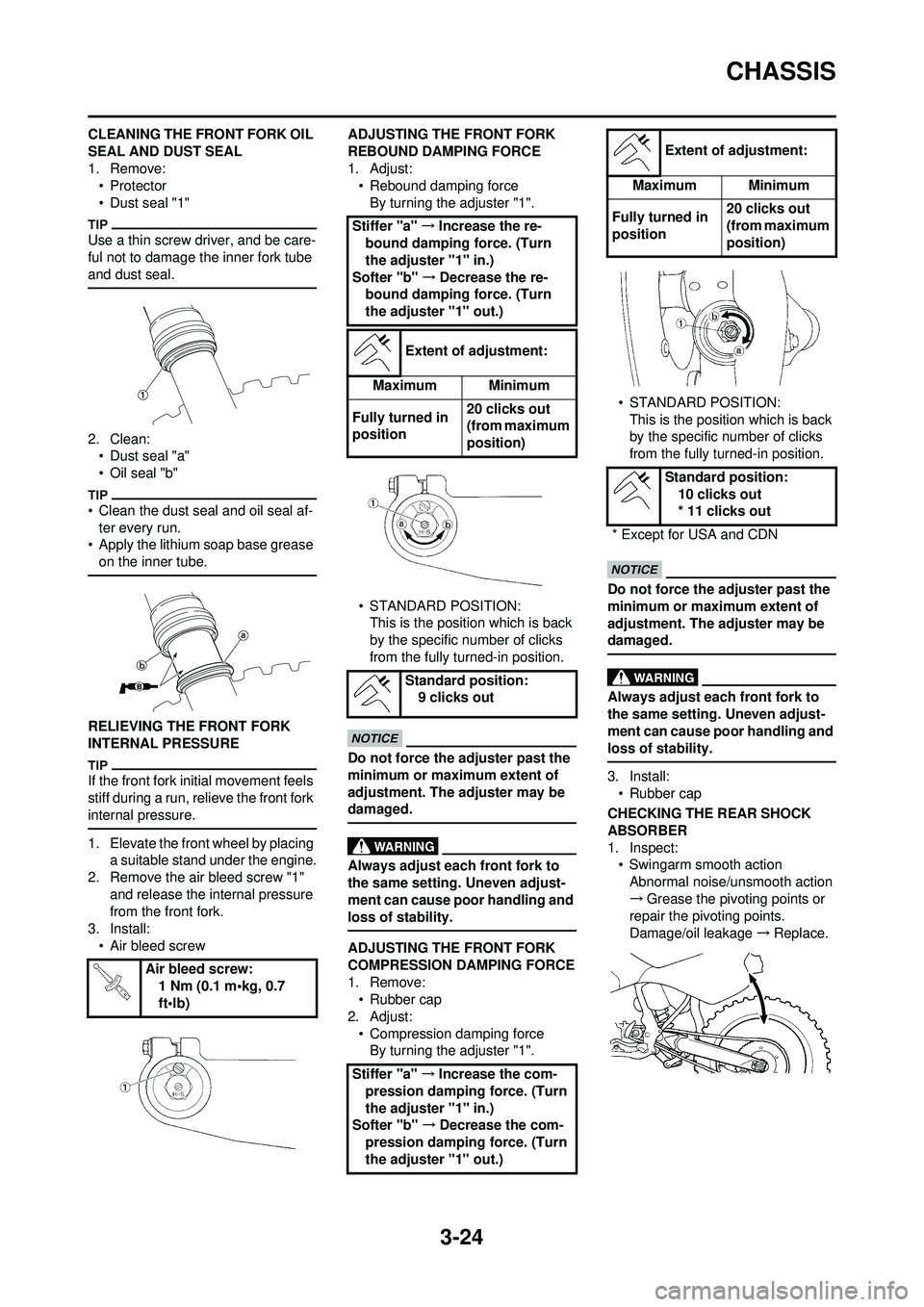
3-24
CHASSIS
CLEANING THE FRONT FORK OIL
SEAL AND DUST SEAL
1. Remove:•Protector
• Dust seal "1"
Use a thin screw driver, and be care-
ful not to damage the inner fork tube
and dust seal.
2. Clean:• Dust seal "a"
• Oil seal "b"
• Clean the dust seal and oil seal af-
ter every run.
• Apply the lithium soap base grease on the inner tube.
RELIEVING THE FRONT FORK
INTERNAL PRESSURE
If the front fork initial movement feels
stiff during a run, relieve the front fork
internal pressure.
1. Elevate the front wheel by placing a suitable stand under the engine.
2. Remove the air bleed screw "1"
and release the internal pressure
from the front fork.
3. Install:
• Air bleed screw ADJUSTING THE FRONT FORK
REBOUND DAMPING FORCE
1. Adjust:
• Rebound damping force
By turning the adjuster "1".
• STANDARD POSITION: This is the position which is back
by the specific number of clicks
from the fully turned-in position.
Do not force the adjuster past the
minimum or maximum extent of
adjustment. The adjuster may be
damaged.
Always adjust each front fork to
the same setting. Uneven adjust-
ment can cause poor handling and
loss of stability.
ADJUSTING THE FRONT FORK
COMPRESSION DAMPING FORCE
1. Remove:• Rubber cap
2. Adjust:
• Compression damping forceBy turning the adjuster "1". • STANDARD POSITION:
This is the position which is back
by the specific number of clicks
from the fully turned-in position.
Do not force the adjuster past the
minimum or maximum extent of
adjustment. The adjuster may be
damaged.
Always adjust each front fork to
the same setting. Uneven adjust-
ment can cause poor handling and
loss of stability.
3. Install:• Rubber cap
CHECKING THE REAR SHOCK
ABSORBER
1. Inspect: • Swingarm smooth action
Abnormal noise/unsmooth action
→ Grease the pivoting points or
repair the pivoting points.
Damage/oil leakage →Replace.
Air bleed screw: 1 Nm (0.1 m•kg, 0.7
ft•lb)
Stiffer "a" →Increase the re-
bound damping force. (Turn
the adjuster "1" in.)
Softer "b" →Decrease the re-
bound damping force. (Turn
the adjuster "1" out.)
Extent of adjustment:
Maximum Minimum
Fully turned in
position 20 clicks out
(from maximum
position)
Standard position: 9 clicks out
Stiffer "a" →Increase the com-
pression damping force. (Turn
the adjuster "1" in.)
Softer "b" →Decrease the com-
pression damping force. (Turn
the adjuster "1" out.)
Extent of adjustment:
Maximum Minimum
Fully turned in
position 20 clicks out
(from maximum
position)
Standard position: 10 clicks out
* 11 clicks out
* Except for USA and CDN